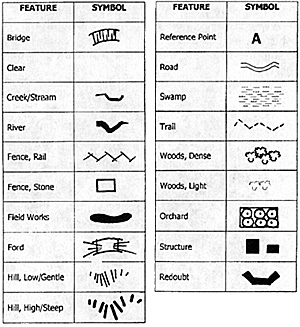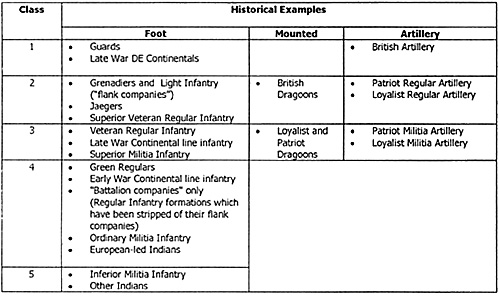KEY TERMS AND CONCEPTS
Overview
He Has Waged Cruel War (HHW) was not written with any particular governing set(s) of miniatures rules in mind. This scenario is thus not quite ready to play "out of the box": players will have to adapt some of the concepts and quantities given to the specific requirements of whatever rules set they prefer. I have tried to provide enough information to make such conversion straightforward. I personally use a home variant of the out-of-print Washington's Wars (David R. Hoffman: Soldiers & Swords, 1993).
Following is an explanation of key terms and concepts sufficient to get you playing the White Plains scenario. HHW goes into much more detail.
Total Figures. These are combat troops, gun models, and leaders only: no messengers, etc.
Terrain Notes. Refer to the chart to identify the different terrain symbols used:

Map. Each grid square represents one square foot on the gaming table. The map concentrates on terrain that did, or plausibly could have, had a significant impact on the outcome at White Plains.
Unit Rosters. The number of figures given for a unit implies nothing about basing; units are based according to the specific rules you use. Figures are foot (infantry) unless otherwise noted:
- Dragoon figures are identified by a letter "c" placed next to the #FIGS for that unit.
- The number of figures in an artillery crew is shown in parentheses [viz. (4)]; in each case, there is only one actual gun model per artillery unit. [10]
SETUP
The (lettered) Reference Point at which units set up is shown. "Reinf." refers to units that enter the table after the start of play. The turn upon which they are first eligible to enter the table is indicated in parentheses.
HHW recognizes three standard formations for foot and mounted troops: Line, Column, and Skirmish Order. Artillery units can be Limbered(i.e., ready to travel) or Unlimbered (deployed). All units that begin the game on the table are directed to set up in one of these formations, or "in any desired formation." If the rules set being used allows units to assume other formations (for example "Open Order", which in practice lies between Line and Skirmish Order), the umpire may permit a unit to set up therein provided such setup accords with: 1) the terrain the unit occupies; 2) the historical ability of the troop type in question, and 3) the general spirit of the situation.
CLASS
Troop units are rated primarily on the extent of their historical reputation for martial skill and elan, secondarily on their track record in the War proper. The following scale is used: [11]

Commanders
A "C-in-C' is that side's senior commander present, whether or not he is also its actual overall commander of the army or theater. By mutual agreement, or if called for by the rules being used, any number of subordinate commanders can be added to the orders of battle shown. All such additional commanders have a default Ability Rating of "Fair." Unless otherwise stated, command figures may begin the game either mounted or dismounted, at the owning player's option.
More Battle of White Plains: 28 October 1776
Back to MWAN #106 Table of Contents
Back to MWAN List of Issues
Back to MagWeb Magazine List
© Copyright 2000 Hal Thinglum
This article appears in MagWeb (Magazine Web) on the Internet World Wide Web.
Other military history articles and gaming articles are available at http://www.magweb.com